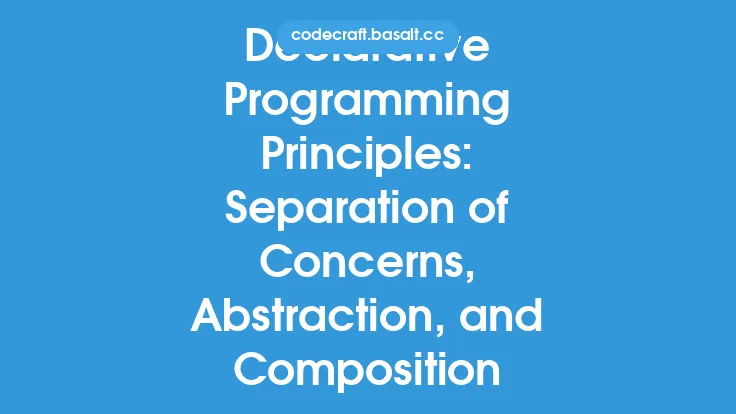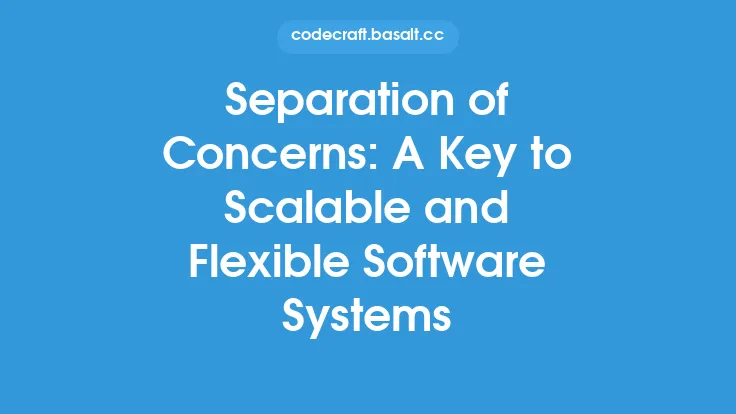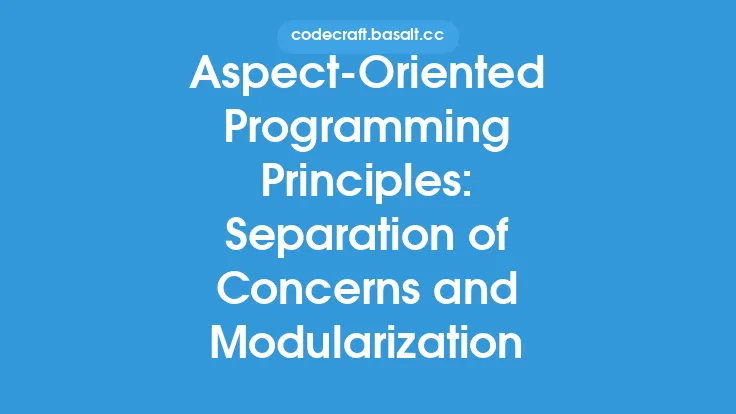When designing and developing software systems, one of the key principles that can help improve code maintainability is the separation of concerns. This principle involves dividing the system into smaller, independent components, each responsible for a specific aspect of the system's functionality. By separating concerns, developers can create systems that are more modular, flexible, and easier to maintain.
Introduction to Separation of Concerns
Separation of concerns is a fundamental principle of software architecture that involves identifying and separating the different concerns or aspects of a system. These concerns can include business logic, data storage, user interface, and security, among others. By separating these concerns, developers can create systems that are more modular and easier to maintain, as each component can be modified or updated independently without affecting the rest of the system.
Benefits of Separation of Concerns
The separation of concerns principle offers several benefits, including improved code maintainability, reduced coupling, and increased flexibility. When concerns are separated, developers can modify or update individual components without affecting the rest of the system, reducing the risk of introducing bugs or errors. Additionally, separated concerns make it easier to reuse code, as individual components can be used in multiple contexts.
Identifying Concerns
To apply the separation of concerns principle, developers must first identify the different concerns or aspects of the system. This involves analyzing the system's requirements and functionality, and identifying the key components that make up the system. Some common concerns that are typically separated include:
- Business logic: This concern involves the rules and processes that govern the system's behavior, such as calculations, data validation, and workflow management.
- Data storage: This concern involves the storage and retrieval of data, such as databases, file systems, or other data storage mechanisms.
- User interface: This concern involves the interaction between the system and its users, such as graphical user interfaces, command-line interfaces, or web interfaces.
- Security: This concern involves the protection of the system and its data from unauthorized access or malicious activity, such as authentication, authorization, and encryption.
Separating Concerns
Once the concerns have been identified, developers can begin separating them into individual components. This involves creating separate modules, classes, or functions for each concern, and ensuring that each component is responsible for a specific aspect of the system's functionality. For example, a system might have separate components for business logic, data storage, and user interface, each with its own set of responsibilities and interfaces.
Implementing Separation of Concerns
To implement separation of concerns, developers can use a variety of techniques, including:
- Modular programming: This involves breaking down the system into smaller, independent modules, each with its own set of responsibilities and interfaces.
- Object-oriented programming: This involves using objects and classes to encapsulate data and behavior, and to separate concerns into individual components.
- Aspect-oriented programming: This involves using aspects to separate concerns that cut across multiple components, such as logging, security, or caching.
- Service-oriented architecture: This involves breaking down the system into separate services, each responsible for a specific aspect of the system's functionality.
Best Practices for Separation of Concerns
To get the most out of the separation of concerns principle, developers should follow some best practices, including:
- Keep each component focused on a single concern: This helps to ensure that each component is modular and easy to maintain.
- Use interfaces and APIs to define component interactions: This helps to ensure that components are loosely coupled and can be modified or updated independently.
- Avoid tight coupling between components: This helps to ensure that changes to one component do not affect other components.
- Use dependency injection to manage component dependencies: This helps to ensure that components are loosely coupled and can be modified or updated independently.
Common Pitfalls and Challenges
While the separation of concerns principle can help improve code maintainability, there are some common pitfalls and challenges that developers should be aware of, including:
- Over-separation: This involves breaking down the system into too many separate components, making it difficult to understand and maintain.
- Under-separation: This involves failing to separate concerns adequately, making it difficult to modify or update individual components.
- Tight coupling: This involves creating components that are too closely tied to each other, making it difficult to modify or update individual components.
- Complexity: This involves creating systems that are too complex, making it difficult to understand and maintain.
Real-World Examples
The separation of concerns principle is widely used in real-world software systems, including:
- Web applications: These systems typically separate concerns such as business logic, data storage, and user interface into individual components.
- Enterprise systems: These systems typically separate concerns such as business logic, data storage, and security into individual components.
- Mobile applications: These systems typically separate concerns such as business logic, data storage, and user interface into individual components.
Conclusion
In conclusion, the separation of concerns principle is a fundamental principle of software architecture that can help improve code maintainability. By identifying and separating the different concerns or aspects of a system, developers can create systems that are more modular, flexible, and easier to maintain. By following best practices and avoiding common pitfalls and challenges, developers can get the most out of the separation of concerns principle and create systems that are more maintainable, scalable, and reliable.





